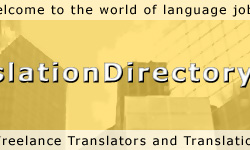Developing a Localization Kit
By Jessica Rathke,
Manager, Sales Strategy & Development,
McElroy Translation,
Austin, Texas 78701 USA
quotes[at]mcelroytranslation.com
http://www.mcelroytranslation.com/

Get the List of 4,500+ Translation Agencies Now!
No Recurring Membership Fees!
See also: Building
a Localization Kit
See also: Preparing
for Translation - Part II of Series. The Localization Kit
What is a localization kit?
A localization kit is comprised of the files
to be localized and accompanying documentation that enables
McElroy to initially prepare a complete proposal, quote,
and schedule for your project and ultimately enables us
to perform the actual localization once the project has
been awarded. The accompanying documentation augments the
file set to be localized and provides us with details regarding
your requirements and expectations.
What should be included?
- A complete set of files to be localized that has been validated against a bill of materials and is organized in the same file structure in which you would like your localized files to be returned
- A list of all proprietary tools that will assist or validate the localization
- A complete set of relevant reference materials
- A directory structure that maintains version control, facilitates the build process, and enables us to replicate the structure for delivering localized versions
- All project files placed in a single archive file such as a Zip file
- All source files for help and documentation
- A compiled version of help such as WinHelp
- The final output format of documentation such as PDF
- Any previously translated material and/or translation memories
- Any language glossaries for all target languages
- Linguistic style guides for all target languages
- All localizable graphics in their source format (Illustrator, Visio, etc.)
Localization kit instructions
With your localization kit you should provide explicit instructions on how the kit is organized, explaining the function of each file in the kit and how localized files are to be returned to you (i.e., directory structure, format, etc.). Other instructions should include:
- Procedures for localizing each file type
- Any proprietary tools and platforms on which they should be run
- Any runtime requirements
- Whether you require delivery of the translation memory and in what format
- List of the applications used to generate all graphics (with platform and version number)
- Who is responsible for generating screen captures
- List of source applications and tools used to create the help and documentation (with platform and version number)
- A description of the HTML-generation process, if applicable
- Any font requirements
- In the case of web-based files, the platforms, browsers, and browser versions on which they should be tested
- A style guide identifying all non-localizable text such as proprietary product names or company titles
How to make localization kits more
useful
Thought should be given to the design of the localization kit to facilitate the localization process through a specific structure and format. This will streamline the transfer and delivery of files and information between you and McElroy, while maintaining a consistent format and providing version control.
One simple way to accomplish this is to automate the localization kit generation process by developing a “build kit” utility that automatically generates a bill of materials including the names and version numbers of all the files needed for your project.
You will also want to create a directory structure that organizes files in the localization kit in a way that helps the localizer to: build the product (if software), easily share files, maintain version control, perform QA checks (for example, on links), and efficiently replicate directory structure for localized versions.
If the project is an update of a previous localization effort, including the prior version’s source language files in addition to the target language files will help maintain long-term consistency.
To many clients with a track record of successful localization and staff dedicated to this part of the business, this article is a basic review. To clients on the other end of the spectrum who may be new to localization, assembling a localization kit may seem like a burdensome amount of pre-project work. We cannot emphasize enough how the right kit pays off in process efficiency and quality output. In fact, most clients fall somewhere in the middle of the spectrum, and our experienced account managers and project managers can assist with kit guidelines and project planning.
Read
more articles - Free!
E-mail
this article to your colleague!
Need
more translation jobs? Click here!
Translation
agencies are welcome to register here - Free!
Freelance
translators are welcome to register here - Free!
Subscribe
to TranslationDirectory.com newsletter - Free!
Take
part in TranslationDirectory.com poll - your voice counts!
|


